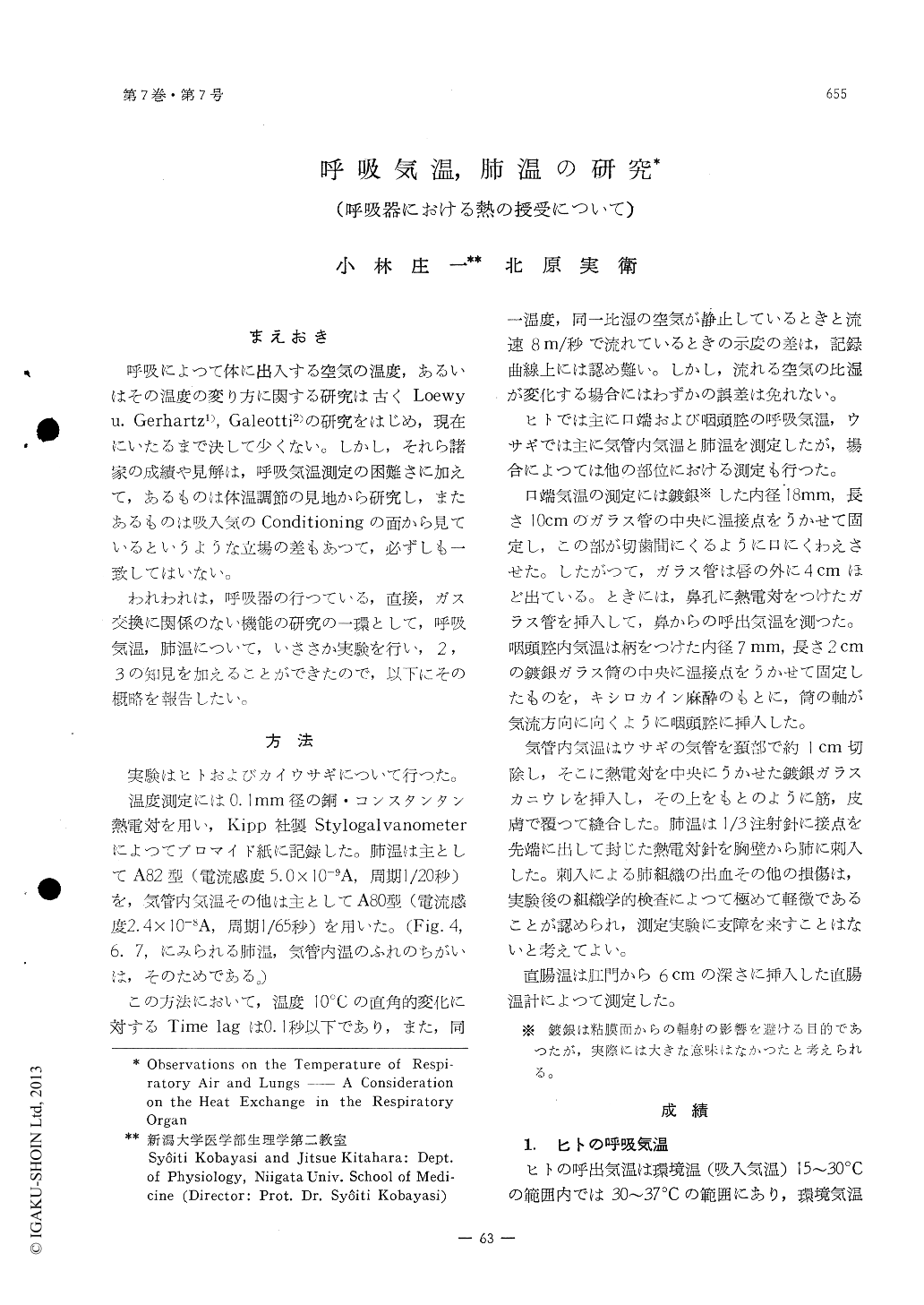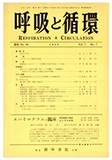Japanese
English
- 有料閲覧
- Abstract 文献概要
- 1ページ目 Look Inside
まえおき
呼吸によつて体に出入する空気の温度,あるいはその温度の変り方に関する研究は古くLoewy u. Gerhartz1),Galeotti2)の研究をはじめ,現在にいたるまで決して少くない。しかし,それら諸家の成績や見解は,呼吸気温測定の困難さに加えて,あるものは体温調節の見地から研究し,またあるものは吸入気のConditioningの面から見ているというような立場の差もあつて,必ずしも一致してはいない。
われわれは,呼吸器の行つている,直接,ガス交換に関係のない機能の研究の一環として,呼吸気温,肺温について,いささか実験を行い,2,3の知見を加えることができたので,以下にその概略を報告したい。
The temperature of the respiratory air and the lung in man and rabbit was recorded under vari-ous experimental conditions. The recording was made by fine cupper-constantan thermojunctions fixed to glass cannulae or to injection needles, and Kipp's Stylogalvanometers. The results were considered in relation to the heat exchange in the respiratory organ.
The air inspired is warmed mainly in the upper respiratory tract; in an environment of 12-15℃, the temperature of inspired air was 31-34℃ in the pharynx or in the trachea (Fig. 5-10). The great warming effect in upper respiratory tract is chiefly attributed to the temperature difference between tract wall and inspired air, and needs not to be so closely connected to the special structure and funciton of oral and nasal cavities (Fig. 5).
The inspired air is warmed (or cooled, if the temperature of inspiring air is higher than the body temperature) to nearly equal to the rectal, and possibly to the pulmonary blood temperature, until it reaches to the lung (Fig. 5, 6, 8, 9, 10). Accordingly, the lung temperature is hardly influenced by the temperature of inspiring air, and it changes with rectal temperature (Fig. 9, 10). In the lung, heat exchange is very scarce. On the temperature of the lung, very slight respiratory change (under 0.1 ℃) is recognized, which shows generally a rise during inspiration and a fall during expi-ration (Fig. 4, 7, 11). This respiratory change is attributable to the change of pulmonary blood flow due to the respiratary movement.
Expiratory air is cooled in the way of expiration by returning the heat, which is given from the respiratory tract during inspiration, to the respiratory tract (Fig. 2, 5, 10). Temperature of expired air is loe er than the body temperature, though it varies with the temperature of inspiring environ-mental air (Fig. 1). Dry heat loss with one breathing is determined by the temperature difference between expired and inspring air.
The cooling of expiring air is mainly performed in upper respiratory tract in rabbits (Fig. 10), and rather evenly in man. The degree of the cooling is modified by vascular conditions of respiratory tract. Cocerning this modification, the thermo-regulatory function of nasal mucosa was discussed.
Heat loss by the respiration is almost carried out in the respiratory dead space. So far as the respiratory heat exchange, the breathing needs not to be greater than the dead space ventilation. Rapid and shallow breathing, such as panting, is efficient for the increase of body heat elimination and conservation of carbon dioxide.
Some experiments were made on reflex effects of thermal stimulations of the skin upon the lung temperature, but, on this problem, further observations are required.

Copyright © 1959, Igaku-Shoin Ltd. All rights reserved.


